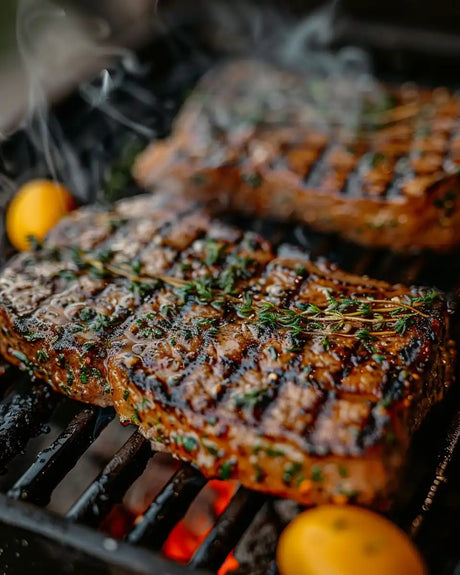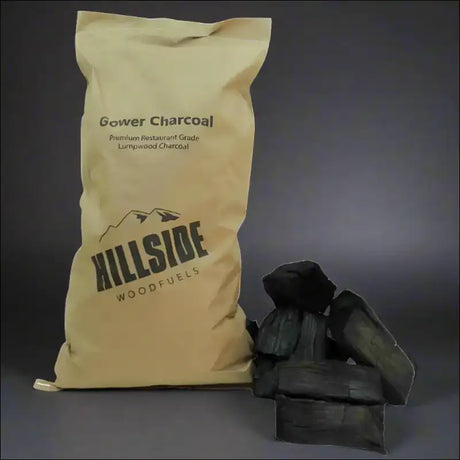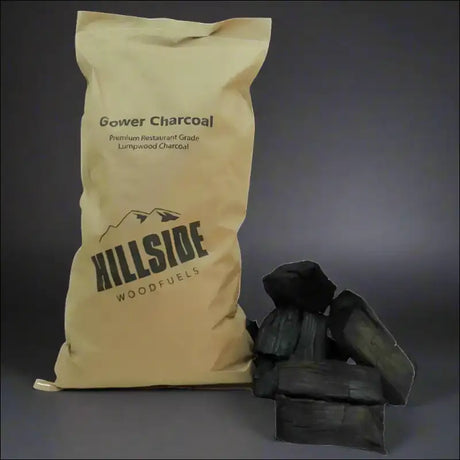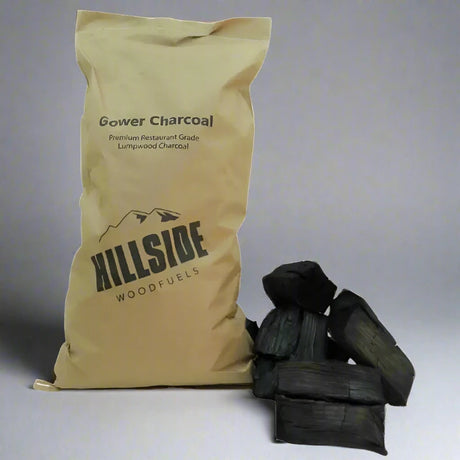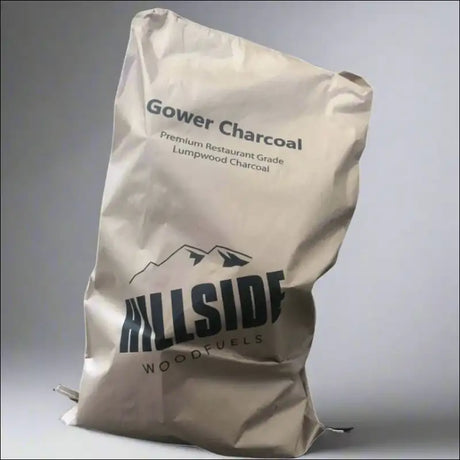Choosing the Best Lump Charcoal for Different Grilled Delicacies

Understanding Lump Charcoal Qualities
When you're gearing up for a grilling session, the choice of lump charcoal can make all the difference. Unlike traditional briquettes, lumpwood charcoal is crafted from 100% natural hardwood, offering a purer and more authentic grilling experience. It's essential to understand the qualities of lump charcoal to enhance the flavor of your food and ensure efficient cooking.
Lump charcoal is known for its ability to light quickly and reach cooking temperatures within minutes. Its high heat output and minimal ash production make it a favorite among grill enthusiasts. For those seeking an even more refined experience, restaurant grade lumpwood charcoal provides a consistent burn and imparts a subtle smoky flavor that can elevate any dish.
Here's a quick guide to the key characteristics of lump charcoal:
- Easy to Light: Ready in minutes, allowing you to start grilling without delay.
- High Heat: Burns hotter and more efficiently than briquettes.
- Minimal Ash: Produces less waste and simplifies cleanup.
- Natural Flavor: Imparts a natural oak and hickory flavor to foods.
- Sustainable: Often made from responsibly sourced hardwood.
Remember, the quality of lump charcoal can vary, so look for options that are free from fillers, chemicals, and treated wood to ensure a pure and natural grilling experience.
By selecting the right type of lump charcoal, you're not just preparing for a meal; you're setting the stage for an unforgettable culinary event. Keep these qualities in mind to guide your selection and use of lumpwood charcoal for grilling, focusing on sustainable sourcing, flavor enhancement, heat management, and minimizing environmental impact.
Pairing Charcoal with Food Types
When it comes to grilling, not all charcoals are created equal. The type of lump charcoal you choose can significantly influence the flavor and outcome of your grilled dishes. For instance, a traditional blend of natural oak and hickory charcoal offers a moderate flavor profile that complements a wide range of foods. Pair it with smoking chips for nuanced taste variations.
Steaks: A thick cut ribeye demands a high-heat charcoal that burns hot and fast, ensuring a perfect sear outside while keeping the inside juicy.
Chicken and Pork: For poultry and pork, opt for a charcoal that burns evenly and lasts long enough to cook through without drying out the meat.
Remember, the key to pairing charcoal with food is to match the charcoal's heat and flavor characteristics with the type of food you're grilling.
For a more gourmet experience, consider using signature flavor briquets, like those infused with garlic, onion, and paprika, to elevate the taste of your dishes. Always ensure that the charcoal you select is suited for the cooking time and flavor profile you desire.
Signature Flavors and How to Achieve Them
When you're aiming for that perfect grilled masterpiece, the type of charcoal you use can make all the difference. Hardwood charcoal is renowned for imparting a robust smoky flavor that's ideal for red meats and hearty vegetables. On the other hand, lump charcoal provides a milder, yet still distinctive, taste that complements a wide range of foods without overpowering them.
To truly master the art of flavor, consider the following points:
- Match the charcoal to your dish: robust flavors for red meats, milder ones for fish and poultry.
- Experiment with wood types: oak, hickory, and mesquite offer varying intensities and nuances.
- Use high-quality charcoal: it burns cleaner and provides a more consistent heat.
Remember, the goal is to enhance the natural flavors of your food, not to compete with them. Choosing the right charcoal is the first step in achieving the signature taste that will have your guests coming back for more.
Mastering the Art of Lighting and Temperature Control

How to Light Charcoal Grill Without Lighter Fluid
Lighting your grill with lump charcoal can be simple and effective, ensuring your food is infused with that authentic, smoky flavor. Start by arranging your lump charcoal in a pyramid shape at the center of the grill. This allows for maximum airflow and an even burn.
- Step 1: Open the grill vents to ensure proper airflow.
- Step 2: Place a natural fire starter, such as a wax fire starter cube or a twisted paper towel soaked in cooking oil, in the center of the charcoal pyramid.
- Step 3: Light the fire starter. As the flames spread, the charcoal will begin to ash over.
- Step 4: Wait for the charcoal to be covered with a light layer of ash, then spread the coals evenly across the grill.
Remember, patience is key. Avoid the temptation to start cooking too early; proper lighting of lumpwood charcoal is essential for BBQ success.
Once the coals are evenly spread and glowing, you're ready to grill. Keep the lid off for high-heat searing or place it on for more controlled cooking. Adjust the vents as needed to maintain your desired temperature, and you're on your way to a successful grilling session.
Controlling Heat for Perfect Grilling
Achieving the right temperature is crucial for grilling success. Start by understanding that the amount of charcoal you use directly impacts the heat level. For high heat, aim for a thick layer of charcoal, while a single layer will provide low heat. Here's a simple guide to help you gauge:
- High Heat: Full chimney of charcoal, spread evenly
- Medium Heat: 3/4 chimney of charcoal, spread with some gaps
- Low Heat: 1/2 chimney of charcoal, arranged in a single layer
Remember, the arrangement of charcoal can affect cooking zones. Create a hot zone for searing and a cooler zone for slower cooking. This technique, known as two-zone cooking, is essential for larger cuts that need to be cooked through after searing.
Controlling heat isn't just about the amount of charcoal; it's also about airflow. Adjust the grill vents to increase or decrease the temperature. Open vents mean more oxygen, which leads to higher heat. Conversely, closing vents will lower the temperature. Keep a close eye on your grill's thermometer to maintain the desired heat level.
Master charcoal grilling with high-quality charcoal, proper lighting techniques, heat control, flare-up prevention, and delicious recipes. By managing these elements, you'll ensure your grilled foods are cooked just the way you like them.
Arranging Charcoal for Optimal Cooking
To achieve the perfect grill, the arrangement of your charcoal is just as crucial as the type you choose. Begin by creating a hot zone where you pile up the charcoal to generate higher temperatures for searing meats. Then, establish a cooler zone with fewer briquettes for slower cooking or to keep food warm. This method allows for greater control and versatility during your cookout.
- Hot Zone: Pile charcoal for high heat; ideal for searing.
- Cool Zone: Fewer briquettes for lower temperature; perfect for slow cooking.
Remember, the goal is to create an environment where you can cook anything from a thick, juicy steak to delicate vegetables with ease. By mastering the distribution of charcoal, you can ensure each dish is cooked to perfection.
Premium charcoals offer power, consistency, and eco-friendly options for grilling. Proper lighting and maintenance tips ensure optimal performance. Infuse food with smoky depth for mouthwatering results. When you're done, you'll appreciate the minimal waste and cleanup thanks to the efficient burn and reduced ash production of quality lump charcoal.
Grill Like a Pro: Techniques for Meats and Vegetables

Grilling Steak to Perfection
When it comes to grilling steak, the choice of charcoal can make all the difference. Restaurant-grade charcoal enhances grilling with superior heat, minimal smoke, and a flavor that can't be matched by standard briquettes. For the perfect steak, start by arranging your charcoal for even heat distribution. This ensures your steak cooks evenly and develops that desirable crust.
Remember, the key to grilling steak to perfection is not just the quality of your meat, but also the mastery of your grill's temperature and the charcoal's performance.
Here's a simple guide to help you achieve that steakhouse-quality sear:
- Preheat your grill to a high temperature before adding your steak.
- Place the steak on the grill and let it cook undisturbed for a few minutes to form a crust.
- Flip the steak only once to ensure even cooking and a juicy interior.
- Use a meat thermometer to check for doneness according to your preference.
- Let the steak rest for a few minutes after grilling to allow the juices to redistribute.
Experiment with different types of lump charcoal and enjoy the process of grilling. Pay attention to ventilation, temperature control, and efficient ignition methods to elevate your grilling game.
Achieving Smoky Flavors in Chicken and Pork
To infuse your chicken and pork with that irresistible smoky flavor, start by choosing the right lump charcoal. BBQ techniques worldwide use lumpwood charcoal for authentic smoky flavor. It's not just about the heat; it's about the taste. Begin with a base of high-quality lump charcoal, which burns hotter and cleaner than briquettes. Then, consider adding wood chips or chunks to complement the natural flavors of your meat. For example, applewood pairs beautifully with pork, while hickory complements both chicken and pork with its robust profile.
Here's a simple guide to help you get started:
- Select a lump charcoal with a natural oak and hickory blend for a moderate smoky profile.
- Preheat your grill to the desired temperature before adding your meat.
- Add wood chips or chunks to the charcoal to introduce additional flavors.
- Maintain a consistent temperature and avoid frequent lid opening to ensure even smoking.
Remember, the key to perfect smokiness is control. Control temperature, add flavor with wood chips, and maintain your grill for optimal performance. This will not only enhance the taste but also create an unforgettable grilling experience.
Whether you're preparing a classic BBQ pulled pork or a sophisticated dish like duck pizza, the right charcoal can make all the difference. Experiment with different hardwood blends and smoking chips to find your signature flavor. And don't forget, a well-maintained grill ensures that each bite is infused with pure, smoky goodness.
Expert Tips for Grilling Vegetables
When it comes to grilling vegetables, the key is to enhance their natural flavors while achieving that perfect char. Start by selecting fresh, seasonal vegetables as they will have the best texture and taste. Cut them into uniform sizes to ensure even cooking, and consider using a grilling basket for smaller pieces that might otherwise fall through the grill grates.
Before placing your vegetables on the grill, it's important to preheat your charcoal. Lumpwood charcoal is ideal for this task, as it burns hot and clean, providing a consistent heat source. For vegetables, you want a medium-high heat to create a crispy exterior without burning. Here's a simple guide to help you with temperature control:
- Zucchini, bell peppers, onions: Grill over medium-high heat for 4-6 minutes per side.
- Asparagus, green beans: Grill over medium heat for 3-5 minutes, turning occasionally.
- Eggplant, thick-cut tomatoes: Grill over medium heat for 5-7 minutes per side.
Remember, the goal is not just to cook the vegetables but to infuse them with a smoky flavor that complements your main dish. Brushing them lightly with oil and your favorite herbs can add an extra layer of taste.
Grilled bread pairs well with tender meats and grilled fruits. Use lumpwood charcoal for a crispy exterior and follow expert grilling techniques for the perfect char. This combination will elevate your grilled vegetables from a simple side to a dish that stands out on its own.
Accessorizing Your Grill for Enhanced Flavor

Selecting the Right Grill Scrapers and Solid Fuels
When you're ready to grill, the choice of solid fuel can make all the difference. Lump charcoal is favored for its ability to heat quickly and give a pure, smoky flavor to your food. Briquet charcoal, on the other hand, burns more consistently and is easier to manage, making it a great choice for beginners or longer grilling sessions.
- Lump Charcoal: Quick heating, pure flavor
- Briquet Charcoal: Consistent burn, easy to manage
- BBQ Pellets: Variety of flavors, efficient
- Cooking Wood: Long-lasting, intense smokiness
Choosing the right fuel for grilling is crucial for taste, cooking time, and the environment. Lumpwood charcoal and briquettes offer different benefits and considerations for a mouth-watering grilled feast. Your selection should align with the type of food you're grilling and the flavor profile you're aiming for.
Remember, the right tools are just as important as the right fuel. A good grill scraper will keep your grill clean and ensure that each dish has the perfect sear without remnants from the last cookout affecting the taste.
The Role of Sauces, Rubs, and Marinades
When you're aiming to elevate your grilling game, the strategic use of sauces, rubs, and marinades can make all the difference. These flavorful concoctions are not just about adding taste; they're about creating a signature profile that complements the smoky flavor and high heat of your charcoal grill.
Sauces offer a quick way to add moisture and surface flavor. Whether you're basting a rack of ribs or glazing a chicken breast, the right sauce can provide a tantalizing finish. Rubs, on the other hand, are perfect for creating a crusty, flavorful exterior. They work best when applied several hours before grilling, allowing the spices to penetrate the meat. Marinades go deeper, tenderizing the meat while infusing it with flavor. A good marinade balances acidity, oil, and seasonings to enhance the meat without overpowering it.
Remember, the key to using these flavor enhancers is moderation. Too much can mask the natural flavors of the food, while too little might not make the desired impact.
Here's a quick guide to help you match your grilled delights with the appropriate flavor enhancer:
- Steak: A robust rub with coffee or chili for a bold crust
- Chicken: A citrus-based marinade for tenderness and zest
- Pork: A sweet and spicy sauce for a sticky, caramelized finish
- Vegetables: A light marinade with herbs to highlight their natural taste
By understanding the role of sauces, rubs, and marinades, you can expertly balance the flavors to complement the unique qualities of charcoal grilling. Remember, quality tools and wood chips can further enhance the experience, emphasizing safety and flavor balance.
Innovative Grilling Accessories and Storage Solutions
Elevate your grilling game with the latest innovative accessories and smart storage solutions. From skewers to smoker boxes, each tool can transform your grilling experience. Consider the following to enhance your culinary creations:
- Skewers: Perfect for kebabs, ensuring even cooking and easy handling.
- Smoker Boxes/Trays: Infuse meats with a deep smoky flavor.
- Grill Toppers/Racks: Ideal for delicate foods that might fall through the grates.
- BBQ Grill Baskets: Keep smaller items contained and easy to turn.
- Grill Covers & Parts: Protect your investment and maintain optimal performance.
Remember, the right accessory can make all the difference in achieving that perfect sear or succulent smoke ring. And when it comes to storage, keep your tools and fuels organized and protected from the elements to ensure they're ready for your next barbecue.
Grill safely with lumpwood charcoal: ventilate, keep distance from flammables, use long tools, let charcoal cool. Optimize flavor with ash-covered charcoal, strategic placement, and airflow. Achieve eco-friendly, flavorful grilling experience.
Exploring Gourmet Grilled Recipes and Pairings

Top Grilled Recipes for Entertaining
When it comes to entertaining, nothing beats the allure of a beautifully grilled dish. The smoky aroma, the sizzling sounds, and the unmistakable taste of charcoal-grilled food can elevate any gathering. Start with crowd-pleasers like Grilled Filet Mignon or Smoked Prime Rib Steak, both of which boast a perfect 5.0 rating from grill enthusiasts. For a lighter fare, Grilled Asparagus offers a fresh, crisp side that complements any main course.
To truly impress your guests, venture into the adventurous with unique recipes such as Grilled Venison Burger with Cherry Salsa or Bourbon Marinated Elk Steaks. These gourmet choices are sure to spark conversation and delight the palate.
Remember, the key to successful grilling is not just the recipe but also the quality of charcoal. Opt for a high-grade option like Gower Restaurant Grade Lumpwood Charcoal, known for its superior heat and clean burn, to ensure your grilled delicacies are cooked to perfection.
Pairing Lump Charcoal with Signature Dishes
When it comes to elevating your grilling game, selecting the right lump charcoal is as crucial as the recipe itself. Imagine the rich, smoky flavors imparted by artisanal lump charcoals, handcrafted from the finest woods. Top producers from Mexico, USA, Indonesia, and more offer a range of gourmet charcoals that can transform your signature dishes into culinary masterpieces.
To help you navigate the choices, consider this simple guide:
- Mexico: Ideal for robust meats, their charcoal adds a bold, smoky flavor.
- USA: Perfect for a balanced taste, complementing both meat and vegetables.
- Indonesia: Known for its intense heat, it's great for searing steaks and locking in flavors.
Remember, the secret to unforgettable grilled dishes lies in the harmony between the charcoal and the food. Experiment with different types to find your perfect match.
Before your next cookout, delve into our buying guide for insights on unique flavors and notable artisanal brands. Enhance your grilling experience with high-quality charcoals that not only cook your food but also infuse it with distinctive tastes that linger on the palate.
Quick and Impressive 30-Minute Grilled Meals
When time is of the essence, but you still crave that char-grilled flavor, quick and impressive 30-minute meals are your go-to option. With the right lump charcoal and a few expert tips, you can whip up a gourmet meal in no time. Here's a list of top-rated quick grill recipes that will leave your guests in awe:
- Grilled Filet Mignon (Rating: 4.8)
- Smoked Chicken Breast on a Pellet Grill (Rating: 5.0)
- Cedar Plank Salmon with Sweet Potatoes & Roasted Garlic (Rating: 4.9)
Remember, the key to a successful quick grilled meal is preparation. Have your ingredients ready and your grill preheated. This ensures that you can focus on the cooking process without any delays.
For those new to grilling, arranging your charcoal correctly can make all the difference. It's not just about the heat, but also about the distribution of it. A common method is the two-zone setup, where one side of the grill is hotter than the other, allowing for both direct and indirect cooking. This technique is perfect for items like Grilled Ribeye (Rating: 4.7) and Smoked Prime Rib Steak (Rating: 5.0), which require different heat levels to achieve perfection.
Conclusion
Choosing the right lump charcoal for your grilling needs can elevate your outdoor cooking experience to new heights. With the insights provided in this article, you now have a better understanding of the types of lump charcoal available and how they can enhance the flavors of your favorite grilled foods. Whether you're searing steaks, smoking ribs, or charring vegetables, selecting a high-quality, 100% natural hardwood lump charcoal like the ones we've discussed can make all the difference. Remember, the best lump charcoal burns hotter, cleaner, and more efficiently, leaving minimal ash and waste behind. It's not just about the heat; it's about the subtle, smoky flavors that infuse your meals, creating unforgettable dining moments. So, the next time you fire up the grill, consider the characteristics of your chosen charcoal and how it complements the food you're cooking. Happy grilling!
Frequently Asked Questions
What are the benefits of using lump charcoal over briquettes?
Lump charcoal is usually ready for cooking in a few minutes, burns hotter and more efficiently than briquettes, and produces less ash, resulting in minimal waste and easier cleanup.
How can I achieve signature flavors when grilling with lump charcoal?
You can pair lump charcoal with smoking chips and chunks for subtle flavor variations. Additionally, using natural hardwood charcoal, such as oak and hickory, adds a delicious live-fire flavor to foods.
What should I look for when choosing lump charcoal?
Look for lump charcoal that is easy to light, contains no fillers, nitrates, chemicals, treated wood, or petroleum products, and is made from 100% natural hardwood. It should also meet EPA environmental guidelines.
Is it possible to light a charcoal grill without lighter fluid?
Yes, you can light a charcoal grill without lighter fluid by using a chimney starter, electric charcoal starter, or natural fire starters to avoid the taste of chemicals in your food.
How do I arrange charcoal for optimal cooking on the grill?
Arrange charcoal in a way that suits your cooking method. For direct heat, spread the coals evenly. For indirect heat, place coals on one side of the grill or around the perimeter, leaving the center empty.
Can I use lump charcoal for both grilling and smoking?
Yes, lump charcoal is versatile and can be used for both grilling and smoking. It provides high heat for searing meats on the grill and can maintain steady temperatures for long smoking sessions.


